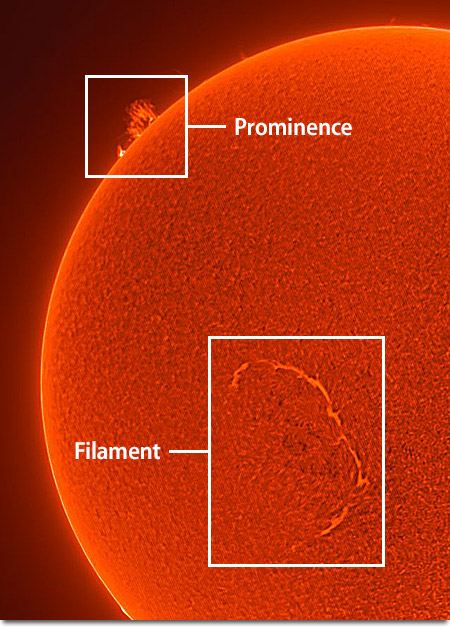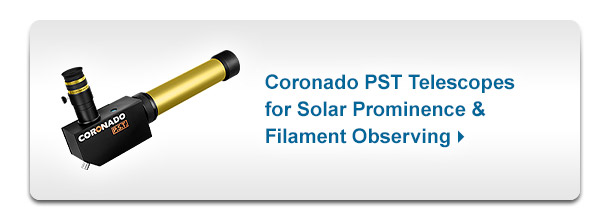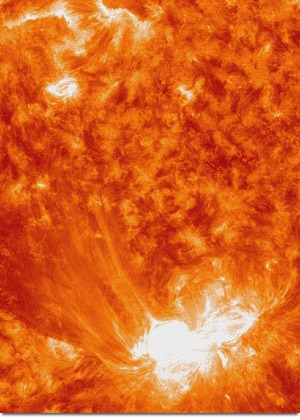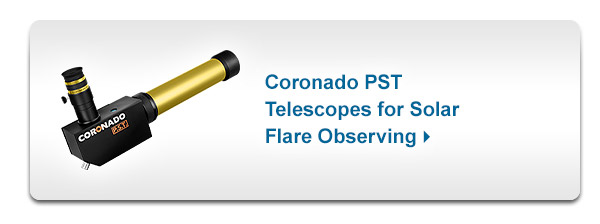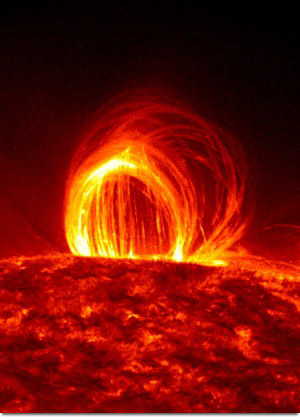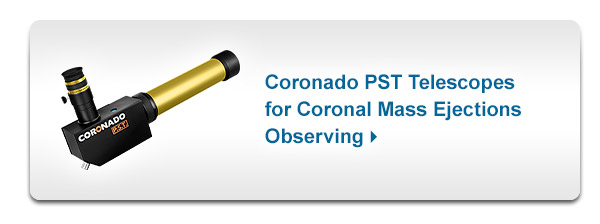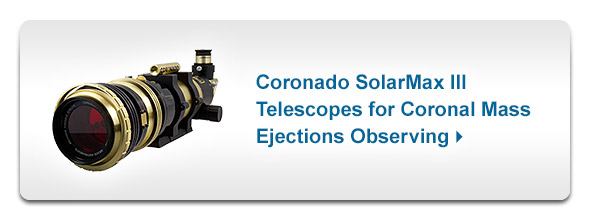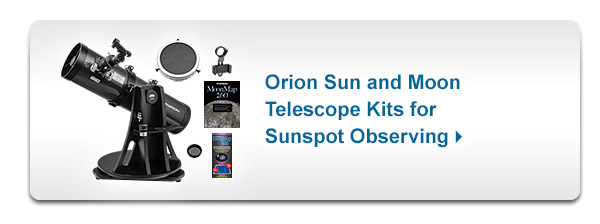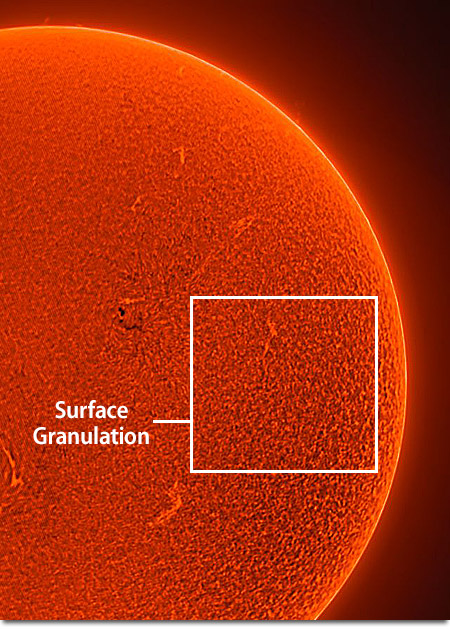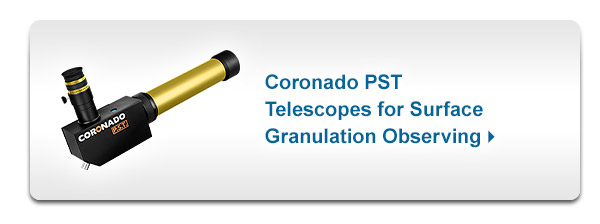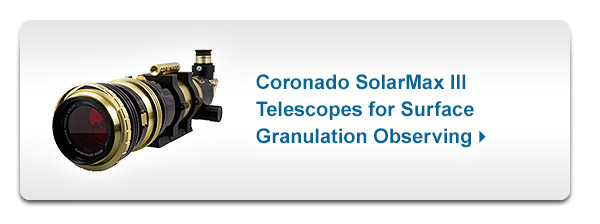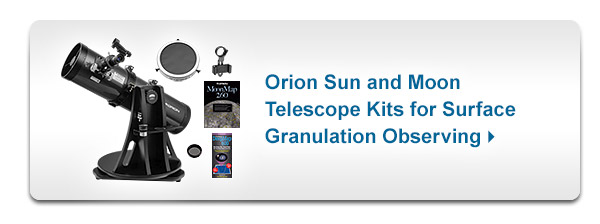
The Sun is a wonderful object to view as you see dynamic changes day to day, even hour to hour in some cases. We have a variety of telescopes and filters to use while observing the Sun, each of which highlight different features. Read on to see what's possible, and best of all, so you don't lose any sleep observing the Sun during the day!
Solar Prominences/Filaments
Solar prominences and filaments are captivating phenomena observed on the Sun, offering a glimpse into the complex dynamics of our star's atmosphere. While both are essentially the same phenomenon, the difference in their appearance — whether they are seen as prominences or filaments — depends on the perspective from which they are viewed against the backdrop of the Sun.
Solar Prominences are immense clouds of relatively cooler, denser gas suspended above the Sun's surface by the Sun's magnetic field. Seen at the edge of the solar disk, they appear as glowing arches or loops of gas that extend thousands of kilometers into the Sun's corona, with temperatures cooler than their surroundings, yet still ranging from about 50,000 to 100,000 Kelvin. Prominences can last for days or even months, and their material can erupt out into space during solar flares or coronal mass ejections.
Filaments are essentially prominences viewed against the solar disk. From this perspective, they appear as dark, snake-like structures due to their cooler temperatures compared to the surrounding photosphere. Filaments can stretch for hundreds of thousands of kilometers across the Sun's surface. Like prominences, they are held above the Sun's surface by magnetic fields and can become unstable and erupt, leading to significant solar events.
Observing these dynamic solar features requires specialized equipment capable of isolating the specific wavelengths of light emitted by the hydrogen gas they are composed of.
How to Observe Solar Prominences/Filaments
The Coronado Personal Solar Telescope (PST) and SolarMax series hydrogen-alpha (H-alpha) telescopes are particularly well-suited for observing prominences and filaments. These telescopes are designed to observe the Sun in the hydrogen-alpha band of the electromagnetic spectrum, a deep red light that reveals the lower atmosphere of the Sun, the chromosphere, in stunning detail.
These telescopes not only provide a window into the ongoing processes within the Sun's atmosphere but also offer amateur astronomers and solar enthusiasts the ability to experience the beauty and power of the Sun from their own backyards. Observing solar prominences and filaments through a Coronado PST or SolarMax telescope can be a mesmerizing experience, as one witnesses the raw energy and dynamic nature of our closest star.
Solar Flares
Solar flares are dramatic bursts of radiation emanating from the sun, showcasing the incredible power of our closest star. These events are triggered by the release of magnetic energy associated with sunspots, regions on the sun's surface that are cooler and exhibit intense magnetic activity. Solar flares stand out as some of the most powerful explosions in our solar system, with the energy released during these events comparable to billions of megatons of TNT.
The genesis of a solar flare lies in the complex interplay of charged particles and the sun's magnetic fields. Over time, the sun's rotation twists and distorts these magnetic fields. When they become overly twisted, they can suddenly snap and realign, unleashing vast amounts of energy. This process heats the solar atmosphere to extreme temperatures, far hotter than the surface of the sun, and propels electrons, protons, and ions to nearly the speed of light.
The impact of solar flares extends across all layers of the solar atmosphere, including the photosphere, chromosphere, and corona, heating the plasma to tens of millions of kelvins and emitting radiation across the electromagnetic spectrum. These flares often occur in active regions near sunspots, where the sun's magnetic fields are particularly strong and complex.
Solar flares are categorized by their strength into three classes: C, M, and X, with C being the weakest and X the most intense. An X-class flare can release such a tremendous amount of energy that it affects Earth's atmosphere, potentially disrupting satellites, communication systems, and even power grids. The flares also eject particles through space, which can lead to phenomena like auroras and affect navigation and communication systems on Earth.
How to Observe Solar Flares
For those interested in observing these magnificent solar phenomena, specialized equipment like the Coronado Personal Solar Telescope (PST) and SolarMax hydrogen-alpha telescopes offer unparalleled views.
These telescopes are specifically designed to observe the sun, allowing astronomers and enthusiasts alike to safely watch solar flares and other solar activities. The Coronado PST and SolarMax utilize hydrogen-alpha (H-alpha) filters, which are adept at isolating the hydrogen-alpha spectral line. This enables the detailed observation of solar flares, prominences, and the intricate structures of the sun's surface and atmosphere in a way that is not possible with standard telescopes.
Coronal Mass Ejections
Coronal Mass Ejections (CMEs) are massive bursts of solar wind and magnetic fields rising above the solar corona or being released into space. Originating from highly active regions on the Sun's surface, these spectacular solar phenomena can eject billions of tons of coronal material and carry an embedded magnetic field that is stronger than the ambient solar wind's magnetic field. CMEs can occur independently or be associated with other solar activities, such as solar flares and filament eruptions, but their scale and impact set them apart, affecting not only the solar system's space weather but also Earth's magnetic field, potentially leading to geomagnetic storms.
The genesis of a CME is closely tied to the Sun's magnetic field dynamics. When magnetic energy that has built up in the solar atmosphere is suddenly released, it can propel vast amounts of plasma and magnetic field into space at speeds ranging from 250 to 3000 kilometers per second. These ejections travel through the solar system, and when they collide with Earth's magnetic field, they can produce stunning auroras, disrupt satellite operations, affect high-frequency radio communications, and even cause power outages.
CMEs are key players in the story of solar-terrestrial relations, with the potential to affect both the beauty and the safety of our technological society.
How to Observe Coronal Mass Ejections
For astronomy enthusiasts and researchers keen on observing these magnificent cosmic events, telescopes equipped with hydrogen-alpha (H-alpha) filters, such as the Coronado Personal Solar Telescope (PST) and SolarMax series, offer an excellent window to the Sun.
These specialized telescopes are designed to observe the Sun in hydrogen-alpha light, a deep red visible light that reveals the lower atmosphere of the Sun, the chromosphere, in exquisite detail. Observing the Sun in this light can unveil the intricate structures and dynamic processes of solar flares, prominences, and the initial stages of coronal mass ejections.

Photo courtesy of David Barnett. Used by permission.
Sunspots
Sunspots are fascinating solar phenomena that manifest as temporary, dark spots on the Sun's photosphere, the Sun's visible surface. They appear darker than their surrounding areas because they are cooler than other parts of the Sun's surface. The temperature in a sunspot's core, the umbra, can be as much as 1,500 to 2,000 degrees Celsius cooler than the surrounding photospheric material, which typically has a temperature of about 5,500 degrees Celsius. This temperature difference is due to the intense magnetic activity associated with sunspots, which inhibits the convective transport of heat from the Sun's interior to its surface.
The size and number of sunspots on the Sun's surface vary over time, following an approximately 11-year cycle known as the solar cycle. During the peak of the cycle, known as solar maximum, sunspots are plentiful, and solar activity, in general, is high. Conversely, during the solar minimum, few sunspots appear, and solar activity diminishes. The largest sunspots can be several times the Earth's diameter, while smaller ones may be comparable in size to our planet.
Sunspots are not merely superficial features but are indicative of the Sun's magnetic field's complexity. They are formed in areas where strong magnetic fields emerge from the Sun's interior and inhibit the convective plasma flows, reducing the surface temperature in these regions. These magnetic fields are generated by the flow of electrically charged ions and electrons in the Sun, a process known as the solar dynamo. The magnetic fields are twisted and sheared by the Sun's rotation, leading to the creation of sunspots and other solar phenomena such as solar flares and coronal mass ejections.
The study of sunspots is crucial for understanding the solar dynamo mechanism and the Sun's impact on space weather, which can affect satellite operations, communication systems, and even power grids on Earth. Sunspots serve as visible markers of the Sun's magnetic field, and their movement and evolution provide valuable information about the inner workings of our star.
How to Observe Sunspots
For astronomy enthusiasts interested in observing these fascinating solar features, the Orion Sun and Moon Telescope Kits, along with Orion and Meade stand-alone white light solar filters, provide excellent tools for safe and effective sunspot observation. These telescope kits and filters are specifically designed to allow amateur astronomers to safely view the Sun without risking eye damage.
Orion Sun and Moon Telescope Kits include telescopes with solar filters that block out the vast majority of the Sun's brightness, making it safe to observe sunspots and other solar phenomena like solar eclipses. These kits are an ideal choice for beginners and seasoned observers alike, offering a convenient and safe way to explore both nocturnal and solar astronomy.
Orion and Meade stand-alone white light solar filters, on the other hand, can be attached to a variety of telescopes, converting them into safe instruments for solar observation. These filters are designed to reduce the Sun's brightness and block harmful ultraviolet and infrared radiation, providing a detailed view of the Sun's surface. Through these filters, observers can directly witness the dynamic nature of sunspots, tracking their development, movement, and eventual decay across the solar disk.
Surface Granulation
Surface granulation on the Sun provides a mesmerizing view into the convective processes that dominate its photosphere, the visible surface of the Sun.
This granulated appearance of the Sun's surface is due to the convection cells known as granules, with each granule acting as a marker of solar plasma motion. These granules are essentially the tops of convective columns within the solar interior, where hot plasma rises to the surface, cools upon losing its heat, and then sinks back into the Sun's depths along the granules' darker, cooler edges. This pattern is a direct visualization of the convective motions that transport energy from the Sun's inner layers to its surface.
Each granule measures about 1,000 kilometers in diameter, which might seem small in comparison to the Sun's vast size, but is actually about the size of many countries on Earth. The granules are short-lived, existing for only about 8 to 20 minutes before being replaced by new ones in a continually evolving pattern. The bright centers of these granules are where the solar material is hottest and rising, whereas the darker intergranular lanes indicate where cooler material descends.
This granulation effect is tied to the Sun's convective zone, a region where energy is transported outward from the solar core towards the surface through the movement of plasma. This zone underlies the photosphere and plays a crucial role in the Sun's energy distribution and in generating its magnetic field through the dynamo process. The detailed observation of these granules provides insights into the dynamics of solar convection, energy transfer mechanisms, and the overall behavior of stellar atmospheres.
How to Observe Surface Granulation
The observation of solar surface granulation demands precise and safe equipment due to the intense brightness and potential harm of direct solar observation. It's essential to use specialized telescopes equipped with appropriate solar filters that can safely reduce the Sun's brightness and block harmful radiation. Orion Sun and Moon Telescope Kits combine quality telescopes with suitable white light solar filters, facilitating the observation of the Sun's surface, including its granulation, without risking eye safety.
Or choose a stand-alone white light solar filter from Orion or Meade. These filters can be attached to a variety of telescopes and will effectively filter out the majority of the Sun's light, allowing for the observation of surface granulation, sunspots, and other solar phenomena in rich detail. The filters are designed to securely fit over the telescope's aperture, blocking harmful ultraviolet and infrared rays, and reducing the Sun's brightness to a safe level. This setup enables both amateur astronomers and seasoned observers to safely explore the intricacies of the Sun's surface, offering a direct window into the processes that power our closest star.
Through careful observation using these telescopes and filters, one can witness the dynamic and ever-changing surface of the Sun.
Note: granulation in a white-light filter is more subtle than in a dedicated H-alpha telescope. If you're using a white-light filter, look carefully around sunspots, especially near the edge of the solar limb to see some of the granulation.
sales, new products, and astronomy.


